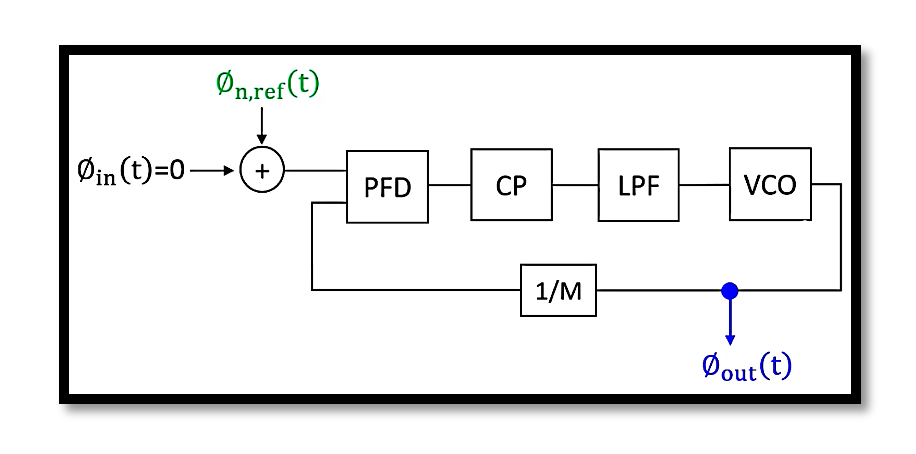
Analysis of Phase Noise Sources in Phase-Locked Loops (PLLs)
Phase noise in Phase-Locked Loops (PLLs) is a critical parameter influencing the performance of communication and signal processing systems. Phase noise arises from various sources within the PLL architecture, each contributing uniquely to the overall noise profile. This detailed analysis explores these sources and presents the necessary calculations and equations to understand and mitigate phase noise in PLLs.
Reference Oscillator Noise
The reference oscillator provides the baseline signal for the PLL. Any noise present in this oscillator directly influences the PLL’s output phase noise. This noise can be modeled as:

where Sϕ,ref(f) is the phase noise power spectral density (PSD) of the reference oscillator, F is a factor representing the oscillator’s noise floor, and f is the offset frequency from the carrier.
Mitigation strategies for reference oscillator noise include using high-quality crystals or resonators and employing environmental shielding to minimize temperature and vibration impacts.
Phase Frequency Detector (PFD) and Charge Pump (CP) Noise
The PFD and CP are integral components in a PLL that compare the phase of the reference signal with the feedback signal from the VCO. The PFD generates an error signal proportional to the phase difference, which is then converted to a control voltage by the CP. Noise in these components can arise from mismatches in the PFD circuitry, power supply variations, and thermal noise in the charge pump. This noise contributes to the overall phase noise, particularly at lower offset frequencies.
The PFD compares the phase of the reference signal with the feedback signal from the VCO and generates an error signal proportional to the phase difference. This error signal is then converted into a control voltage by the CP. The noise introduced by the PFD and CP can be modeled as:

where KPFD is a constant representing the PFD and CP noise characteristics, and f is the offset frequency.
Loop Filter Noise
The loop filter smooths the control voltage before it is applied to the VCO. This filter typically consists of passive components like resistors and capacitors or active components like operational amplifiers. Each component can introduce its noise, with thermal noise from resistors and flicker noise from active elements being the most common. The design of the loop filter significantly affects the PLL’s ability to suppress noise and achieve a clean output signal. Noise in the loop filter can be expressed as:

where KLF is a constant representing the loop filter noise characteristics.
Voltage-Controlled Oscillator (VCO) Noise
The VCO is a critical element in the PLL that generates an output signal whose frequency is controlled by the input voltage from the loop filter. The VCO’s phase noise is a significant contributor to the overall phase noise, especially at higher offset frequencies. This noise arises from various factors, including the quality of the components used in the VCO circuit, the design of the oscillator itself, and environmental influences. The VCO noise can dominate the phase noise profile if not adequately controlled. The VCO converts the control voltage into an output frequency. Its phase noise can be modeled as:

where Sϕ,VCO(f) is the phase noise PSD of the VCO, L(f0) is the VCO’s noise factor at the carrier frequency f0, and f is the offset frequency.
Feedback Divider Noise
The feedback divider scales down the VCO output frequency to match the reference frequency, enabling phase comparison by the PFD. Noise in the feedback divider, which includes digital switching noise and quantization noise, can also contribute to the overall phase noise. This noise becomes more prominent at higher division ratios and needs careful consideration during the design phase. The feedback divider scales the VCO output frequency to the reference frequency range, enabling phase comparison. Noise from the feedback divider can be expressed as:

where KDIV is a constant representing the feedback divider noise characteristics.
Interplay and Mitigation of Noise Sources
The overall phase noise of a PLL is a result of the combined contributions from all these sources. The interplay between these noise sources can be complex, with certain sources dominating at different frequency offsets. For instance, reference oscillator noise is more critical at lower offset frequencies, while VCO noise tends to dominate at higher offsets. Understanding this interplay is crucial for effective noise mitigation.
Mitigation strategies involve a combination of design optimizations and component selection. For instance, using a higher-quality reference oscillator can significantly reduce low-frequency phase noise. Similarly, optimizing the loop filter design to strike a balance between sufficient bandwidth and low noise is crucial. Reducing power supply noise and using low-noise, high-speed digital components for the feedback divider can also enhance overall PLL performance.
Take our entry level course (Below) for free using coupon code RAHRF101BLOG
RF Fundamentals, Basic Concepts and Components – RAHRF101
For limited time take an additional 10% off of all our courses using coupon code RFCERT10
Rahsoft RF Certificate and courses
Conclusion
Phase noise in PLLs is a multifaceted issue influenced by several internal noise sources. By thoroughly understanding the contributions from each source and implementing targeted mitigation strategies, designers can optimize PLLs for minimal phase noise. This optimization is vital for applications requiring high signal stability and clarity, such as in advanced communication systems and precise signal processing tasks. The detailed analysis and strategies discussed in this blog provide a solid foundation for improving PLL performance in various high-tech applications.

Learn more about this topic by taking the complete course ‘Phase Lock Loop System Design Theory and Principles RAHRF469’. Watch the course videos for more detailed understanding. Also checkout other courses on RF system and IC design on https://rahsoft.com/courses/. Rahsoft also provides a certificate on Radio Frequency. All the courses offer step by step approach.



